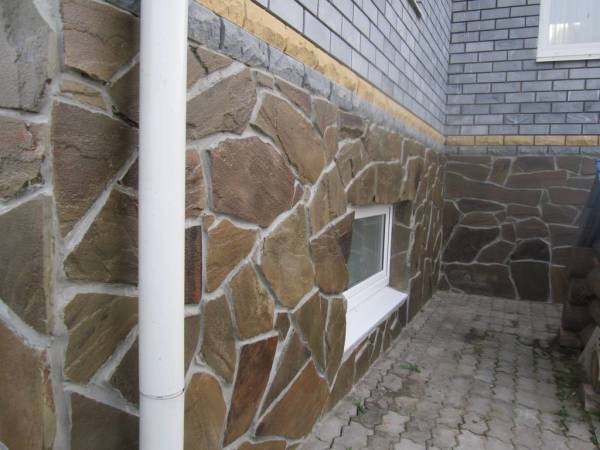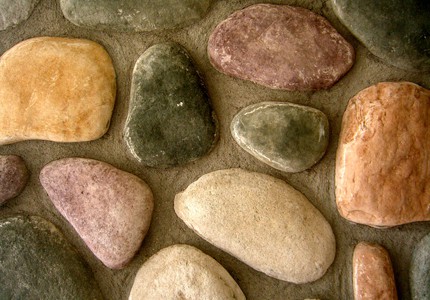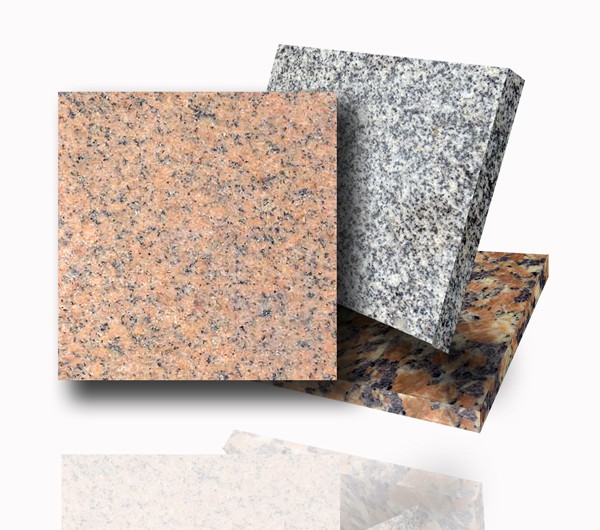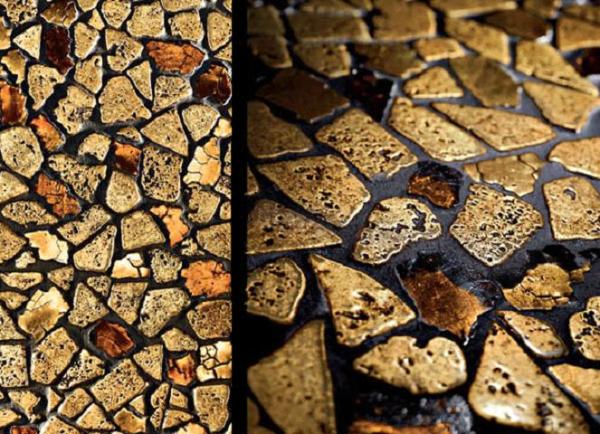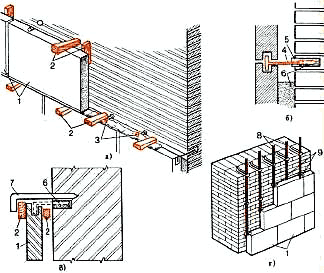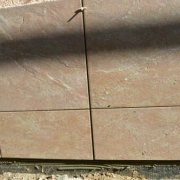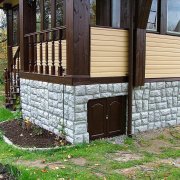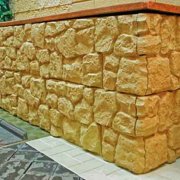Facing the base with natural stone: types of material and installation steps
Facing the basement with natural stone is considered the most popular. All this for the reason that the material has a very attractive appearance and excellent technical characteristics.
The content of the article
What types of natural stones are used in decoration
Facing the basement of the house with natural stone can be performed using:
- Granite
- Sandstone.
- Shell rock.
- Wild stone (quartzite, slate).
Let's consider in more detail:
- Most common option base trim is granite. He has a very original appearance. The size of the stone is quite diverse. There is it in the form of tiles, the thickness of which is from 1 cm or in the form of stone blocks, which are used for masonry walls or decorative structures.
- The next most popular is sandstone. This stone is significantly different from granite. It has an external design in only one color scheme - sand.
Its sizes are also different. There are also tiles and stones.
Tip. It is not recommended to build walls or other structures from sandstone, since its structure is based on sand, and it does not have sufficient strength.
- Facing the base of natural stone can be done by shell rock. It is stronger and more reliable than sandstone and, as a rule, it goes only in thick plates.
In some cases, there are solid blocks from which the structure is erected. It has only one shade - closer to yellow. The whole structure of such a stone consists of pores and for this reason it is not worth it to leave it for too long.
Tip. In order for the shell to serve as a finish for a long time, its surface must be necessarily covered with a protective layer. Use for this a special primer or simple varnish.
- Wild stone for facing the basement is also very popular. It is called "Limestone", as it is used for decoration in slabs, which can be of different sizes and thicknesses.
The most common are shale and quartzite. They have a fairly dense structure, thanks to which they do not perceive weather and climatic influences. - The color scheme of such material is quite diverse. There are dark and light shades. Streaks that adorn it are visible on the surface of the stones.
Tip. Facing the basement with wild stone can be performed by other rocks that are of natural origin. Most importantly, the material should be mined in those regions that will be similar in climate to the climate of the region in which the house is built.
- Facing socles wild stone can also be carried out by sandstone, as some of its species are also considered "wild" and are not subjected to special treatment.
Tip. Marble slabs are often used in home decoration, only in exterior decoration it is not recommended to use such material, since in some regions its structure can undergo deformation and for this reason the exterior design of the structure will be damaged.
How to choose a natural stone correctly
The first thing you need to focus on is the budget for the finish. If it is not too big, then you can use shell rock or sandstone. Quartzite also belongs to the economy category.If the amount allows, then you can choose a more attractive granite.
Further:
- The next step will be the choice of colors. The shade of natural stone for finishing the basement depends on the design of the building itself. It can also be several tones darker than the entire color scheme of the structure.
Tip. When choosing a natural stone, the seller must ask for certification documents that indicate that the stone does not emit radiation and is of natural origin.
Technical characteristics of natural sinter
A natural stone for facing the basement of the house has the main property - environmental friendliness. It will not harm human health and the environment.
It is very durable and reliable. On its surface, it can withstand almost any load. All this thanks to a very dense structure.
Features and Benefits:
- The stone does not burn and does not respond to changes in weather and climatic conditions, as it was formed in nature. It is free to tolerate temperature fluctuations (withstands low and high temperature conditions).
- The life of the material is almost unlimited. It can last 100 years.
Only in this case should its operating conditions be normal. If the stone is in tiles, then it has a fairly simple and quick installation - The only drawback of natural stone will be its price. It is quite high compared to other types of finishing material.
- Natural stone is moisture resistant and can be cleaned with plain water and rags and it is not recommended to use chemical cleaners on its surface. They are able to damage the protective surface layer of the stone and thereby begin to destroy its structure.
Tip. For the finishing of the base, in addition to natural stone, you can use artificial, which in appearance does not differ from natural, only costs several times lower.
Types of natural stone surfaces
Natural stone has several types of surfaces that have an original appearance and are all popular.
Surface:
- Polished, which may have some roughness, but its structure is smooth.
- Chipped - resembles a torn surface of an artificial stone. It is uneven and uneven. It has a certain relief.
- Polished is a glossy surface, as during processing the stone is polished using special equipment. It is perfectly flat.
- Rough - the surface is practically not processed using special tools and equipment, and it is precisely it that is considered the natural surface of the material.
Tip. When choosing the surface of natural stone, it is worth considering how simple and quick it will be cleaned. If there are a lot of different recesses on the surface, and the color of the material is light, then it is better not to use it for facing the base.
What can combine natural agglomerate for finishing the base
Facing the basement of the facade with natural stone can be combined with any other finishing material on the surface of the walls.
The most common option is plastered walls with natural stone on the base. Very often you can find natural agglomerate on the base, and artificial stone on the walls.
So:
- Plastic or siding panels with various surface designs are also used. There are imitations of brick or masonry.
Tip. It is not recommended to use a plastic lining for finishing the building using natural stone on the base, as the house will not look aesthetically pleasing.
The photo shows the various design options for the building with natural stone on the base.
How to install natural stone on the base
The base is usually built of red refractory bricks. It has excellent strength and can withstand heavy loads.
A natural facing stone for the base it has a very large weight and for other surfaces it will be mandatory to strengthen them.
The next step is to level the surface:
Tip. If the masonry is made evenly and there are no deposits of concrete mortar on the surface, then you will not need to level the surface.
- The main thing to do is primer. It contributes to a stronger fixation of the material.
Such work is carried out using a special tool - a primer and in order to do everything correctly, the instruction for it is preliminarily studied. - The alignment of the surface for the installation of natural stone is best done with a solution of concrete. Plaster is not able to withstand a fairly large load.
And the reinforcement is carried out by mounting on the surface of the reinforcing mesh with small cells. It is attached using concrete mortar. - The preparation of concrete mortar is quite simple. There are standard proportions and materials for this.
Used sand and cement, water. For 1 part cement 3 parts sand. Water is already added during the mixing process and to a certain consistency of the product.
Tip. To make the solution more durable and with a denser structure, it is necessary to use 1 to 2 or 1 to 1 proportions.
To apply the solution to the surface using a spatula and trowel. All work is carried out according to the type of work with plaster, only at their completion sandpaper is not used, since concrete is not exposed to this type of impact.
Mounting plates of natural stone
Do it yourself with your own hands to install natural agglomerate on the surface will not be difficult.
For them you will need:
- Mortar of concrete, which is also prepared independently.
Tip. Special glue is not used for fixing natural stone, since it does not have high strength after drying.
- Construction level, so that the surface of the finish is flat after the installation of each element.
- A spatula for applying the solution to the surface, since it is not necessary to impose it on the back of the stone.
- Special tools for cutting stone if necessary. This can be a tile cutter if stones of not too large thickness and those that do not have a dense structure are used. For others, diamond wheels will do.
The concrete solution has a gray tint, which is not suitable for every stone decoration. For this reason, you can add a coloring pigment to it and give it a different color.
The video shows an example of mounting natural stone in slabs on the basement surface.
